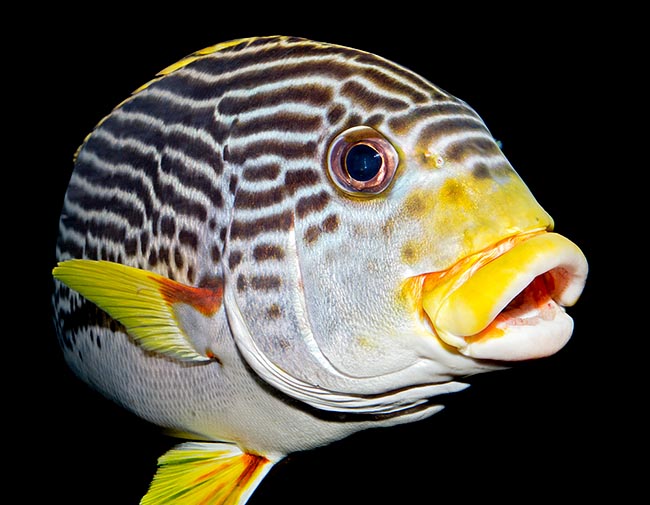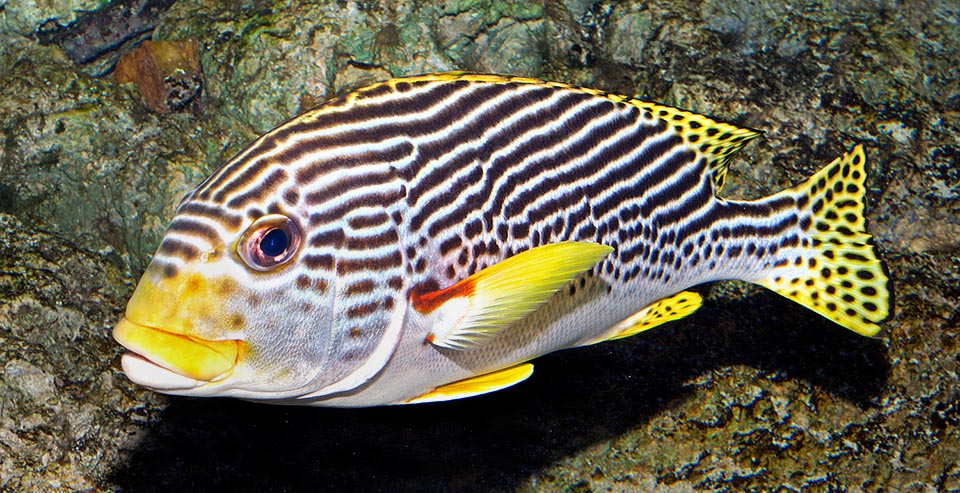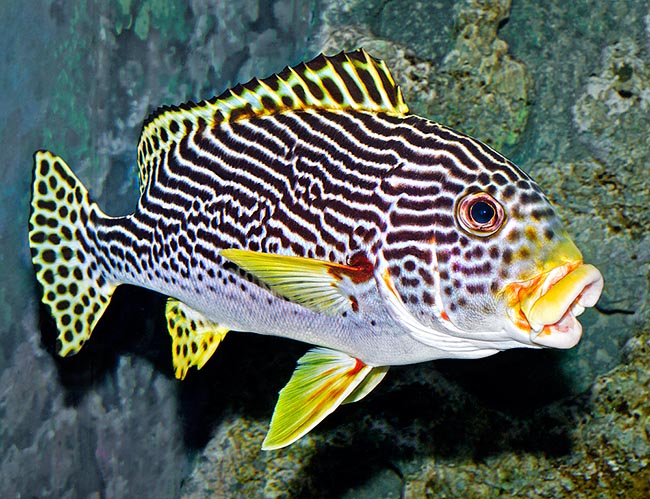Family : Haemulidae

Text © Giuseppe Mazza

English translation by Mario Beltramini

Very similar to Plectorhinchus vittatus, which has its body painted with horizontal stripes, Plectorhinchus lineatus is mainly distinguishable by the marked diagonal black barred design which breaks into spots towards the belly © Giuseppe Mazza
They are mostly marine or brackish waters fishes, reminding at first sight, due to their look, of the sparids or the sciaenids.
They rarely exceed 60 cm in length and often occupy an important rôle in the human alimentation.
The name of the genus, Plectorhinchus, comes from the Greek “epiplektos” = twined, and “rygcos” = snout, with reference to the big lips full of folds. The specific name, lineatus, means in Latin “lined, banded”, in reference to the stripes of the livery.
Zoogeography
The Plectorhinchus lineatus inhabits the tropical waters of the Indo-Pacific.
Indicatively, we find it along the Asian coasts, starting at the Maldives and advancing towards east, at Sri Lanka, India, Malaysia, Indonesia, Vietnam, China, Taiwan, Ryukyu Islands, Japan, Ogasawara Islands, Papua-New Guinea, the Philippines, Palau islands, Guam, Australia, Micronesia, Solomon Islands, New Caledonia, Vanuatu and Niue Island, which counts as the easternmost limit of its distribution.

Adults may exceed 70 cm. They live alone or in groups swimming synched looking for molluscs, crustaceans and minnows © Giuseppe Mazza
It lives in relatively shallow waters, without exceeding the depth of 35 m. Frequent in gulfs, bays and lagoons, among the corals, where the young grow sheltered by the madrepore branches.
Morpho-physiology

In the subadults the dark belts are decidedly horizontal © Giuseppe Mazza
Big fleshy lips and long, solid caudal peduncle with rounded fin in the young, which goes truncate when they grow.
The dorsal fin has 12-13 spiny rays (third to fifth are the longest) and 19-20 soft ones, whilst the anal carries 3 spines and 7 soft rays and the pectoral ones have 17 unarmed rays. Like in Plectorhinchus chaetodonoides there is a major difference between the juvenile and the adult livery.
When smaller than 15 cm the overall colour is reddish brown with large white spots. Then the white extends to almost all the body, crossed by dark horizontal and parallel bands. The eyes and the lips are yellow.
The subadult individuals keep the horizontal black bands, although they only extend down to the pectoral fins, leaving the ventral region white. The dorsal, anal and caudal fins are yellow and covered with large black spots.
In the adults the stripes get increasingly oblique, even breaking into spots at their lower region, at the border with the ventral white colour. It can also be noted a showy reddish spot at the base of the pectoral fins, with traces of this same tone around the thick lips and on the ventral fins.

Due to its livery beauty Plectorhinchus lineatus is at times guest of large public aquaria © Giuseppe Mazza
The Plectorhinchus lineatus is a fish that lives solitary or in groups that often swim synched, forming a sort of a multicoloured wall that advances, ravenous, looking for benthic mollusks and crustaceans and some little fish.
It is active mainly during night, when it swims over sandy plains or seagrass beds looking for food, whilst at day it rests among the rocks and corals.
The reproduction takes place in the open sea with eggs abandoned to the currents.
With a moderate vulnerability index, 37 over 100, Plectorhinchus lineatus is not an endangered species at the current time. Albeit having a more limited distribution in comparison to its relatives its situation is not too worrying thanks to the fast development of their fry and their good resilience, having that it takes 1,4-4,4 years to double a decimated of population of this species.
Synonyms
Perca lineata Linnaeus, 1758; Lutjanus pentagrama Lacepède, 1802; Diagramma goldmanni Bleeker, 1853; Diagramma radja Bleeker, 1853; Diagramma haematochir Bleeker, 1854; Gaterin gaterinoides Smith, 1962.
→ For general information about FISH please click here.
→ For general information about BONY FISH please click here
→ For general information about CARTILAGINOUS FISH please click here.
→ To appreciate the BIODIVERSITY of BONY FISH please click here.
→ To appreciate the BIODIVERSITY of CARTILAGINOUS FISH please click here.
